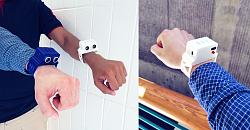Nineteen million Americans have significant vision loss. Over 70% of these are not employed full-time, and more than a quarter live below the poverty line. Globally, there are 36 million blind people, but less than half use white canes or more costly commercial sensory substitutions. The quality of life for visually impaired people is hampered by the resultant lack of independence. To help alleviate these challenges this study reports on the development of a low-cost (<$24), open-source navigational support system to allow people with the lost vision to navigate, orient themselves in their surroundings and avoid obstacles when moving. The system can be largely made with digitally distributed manufacturing using low-cost 3-D printing/milling. It conveys point-distance information by utilizing the natural active sensing approach and modulates measurements into haptic feedback with various vibration patterns within the distance range of 3 m. The developed system allows people with lost vision to solve the primary tasks of navigation, orientation, and obstacle detection (>20 cm stationary, moving up to 0.5 m/s) to ensure their safety and mobility. Sighted blindfolded participants successfully demonstrated the device for eight primary everyday navigation and guidance tasks including indoor and outdoor navigation and avoiding collisions with other pedestrians.
Video presentation:
For more information, go here:
https://www.appropedia.org/Low-cost_...ually_impaired
To download the paper:
https://www.academia.edu/40218183/Lo...ually_Impaired



 LinkBack URL
LinkBack URL About LinkBacks
About LinkBacks



 Reply With Quote
Reply With Quote


Bookmarks